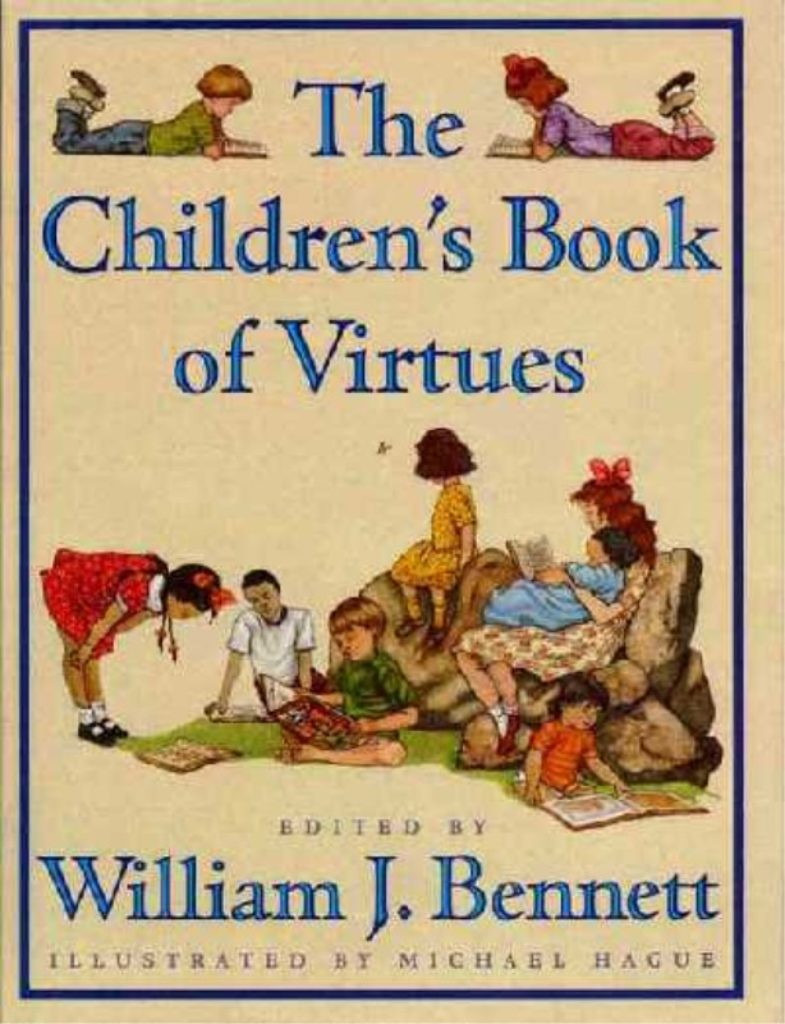This story collection by William J. Bennett is published by Simon & Schuster and is written for kids ages 5 to 10. The age range reflects readability and not necessarily content appropriateness.

This story collection by William J. Bennett is published by Simon & Schuster and is written for kids ages 5 to 10. The age range reflects readability and not necessarily content appropriateness.
Former U.S. Secretary of Education William Bennett aspires to make time-honored, morally rich tales (along with colorful, detailed pictures) readily available to children everywhere. His anthology includes legends, fables, poems, prayers and other lessons in virtue along with illustrations reminiscent of days gone by. Each tale falls into one of four categories: (1) courage/perseverance; (2) responsibility/work/self-discipline; (3) compassion/faith; or (4) honesty/loyalty/friendship. Readers learn through the bravery and wisdom (and sometimes, through the poor decisions) of the characters about some of the choices that will serve them best in life.
Two rhyming prayers (“A Child’s Prayer” and “God Make My Life a Little Light”) note God’s care and forgiveness and ask Him to teach us to be helpful and giving. In the rhyme “Little Fred,” Fred demonstrates a proper bedtime routine by saying his prayers. St. Francis in “The Sermon to the Birds” urges his winged friends to love and praise God for His providence, using language taken from the Sermon on the Mount. In “The Honest Disciple,” a student tells his rabbi that if he found money that didn’t belong to him, he would be tempted to keep it. He should therefore pray that God would help him resist temptation and do the right thing.
Numerous talking animals, fairies and other objects appear in many of the selections, along with other instances of fairy tale magic. One girl climbs to the heavens in “The Stars in the Sky,” and another’s water dipper turns into a fountain in “The Legend of the Dipper.” In “Hercules and the Wagoner,” Hercules asserts that heaven helps those who help themselves. St. George battles a dragon.
A Native American man named Strong Wind (“The Indian Cinderella”) has the ability to make himself invisible; his sister magically restores beauty to a girl, and Strong Wind turns the girl’s cruel sisters into trees.
Selections such as “There Was a Little Girl,” “George Washington and the Cherry Tree,” “Please” and “Over in the Meadow” show parents training and disciplining their children. Selections such as “Kindness to Animals” and “The Sermon to the Birds” urge readers to show compassion to animals. The knight in “St. George and the Dragon” and the woodcutter in “The Honest Woodman” demonstrate integrity and put the needs of others first. Negative authority figures appear in “The King and His Hawk” (a king angrily kills the bird who saved his life), “Someone Sees You” (a father makes his daughter serve as a lookout while he steals from neighboring fields), and “Why Frog and Snake Never Play Together” (Frog-child and Snake-child’s parents pit them against each other just because they’re different from each other, forcing them to discontinue their budding friendship).
Mild violence appears in “King George and the Dragon” when the knight slays the beast and “The King and His Hawk” when the king kills the hawk.
None
If your children have read this book or someone has read it to them, consider these discussion topics:
Why is it important not to give up when you face difficulties?
What did you learn about manners from the stories in this book?
Why is it important for you to learn good manners and demonstrate them to others?
Characters, such as the animals in “The Little Red Hen,” the king in “The King and His Hawk,” the father in “Someone Sees You” and the shepherd in “The Boy Who Cried Wolf,” made some bad choices.
What were they, and what lessons did they learn from their choices?
Characters such as Peter in “The Little Hero of Holland,” the knight in “St. George and the Dragon,” the young sister in “The Indian Cinderella” and the woodcutter in “The Honest Woodman” made good choices.
What were they, and how were they rewarded for their choices?
How did the main characters in “The Little Hero of Holland,” “St. George and the Dragon,” “The Legend of the Dipper” and “Little Sunshine” help others?
What does the Bible say about helping other people?
Which story or poem did you like best?
Book reviews cover the content, themes and world-views of fiction books, not their literary merit, and equip parents to decide whether a book is appropriate for their children. A book’s inclusion does not constitute an endorsement by Focus on the Family.
You can request a review of a title you can’t find at [email protected].